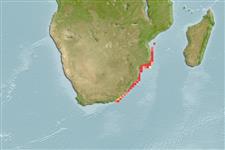Elasmobranchii (sharks and rays) >
Torpediniformes (Electric rays) >
Narkidae (Sleeper rays)
Etymology: Heteronarce: Greek, heteros = other + Greek, narke = numbness (Ref. 45335).
More on author: Regan.
Environment: milieu / climate zone / depth range / distribution range
Ecology
Marine; demersal; depth range 73 - 329 m (Ref. 6589). Subtropical; 20°S - 35°S, 27°E - 37°E (Ref. 114953)
Western Indian Ocean: southern Mozambique to Algoa Bay, South Africa (Ref. 5578).
Size / Weight / Age
Maturity: Lm ? range ? - ? cm
Max length : 25.0 cm TL male/unsexed; (Ref. 6589)
Short description
Identification keys | Morphology | Morphometrics
Small ray with an elongated, narrow disc and a small, narrow caudal fin (Ref. 5578). Plain brown above, white below (Ref. 5578).
Found on the outer shelf and upper slope (Ref. 5578). Life history unknown. Males reaches maturity at ca. 17 cm TL (Ref. 114953).
Life cycle and mating behavior
Maturities | Reproduction | Spawnings | Egg(s) | Fecundities | Larvae
Compagno, L.J.V., 1986. Narkidae. p. 113-114. In M.M. Smith and P.C. Heemstra (eds.) Smiths' sea fishes. Springer-Verlag, Berlin. (Ref. 6589)
IUCN Red List Status (Ref. 130435)
Human uses
Fisheries: of no interest
Tools
Special reports
Download XML
Internet sources
Estimates based on models
Preferred temperature (Ref.
123201): 15.2 - 22, mean 18.1 °C (based on 27 cells).
Phylogenetic diversity index (Ref.
82804): PD
50 = 0.5627 [Uniqueness, from 0.5 = low to 2.0 = high].
Bayesian length-weight: a=0.01000 (0.00244 - 0.04107), b=3.04 (2.81 - 3.27), in cm total length, based on all LWR estimates for this body shape (Ref.
93245).
Trophic level (Ref.
69278): 3.2 ±0.3 se; based on size and trophs of closest relatives
Resilience (Ref.
120179): Low, minimum population doubling time 4.5 - 14 years (Assuming fecundity<100).
Fishing Vulnerability (Ref.
59153): Low vulnerability (15 of 100).
